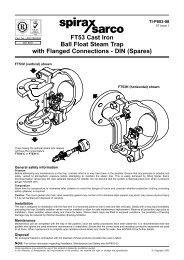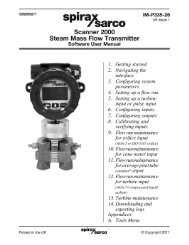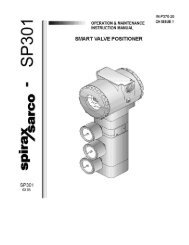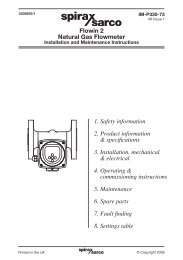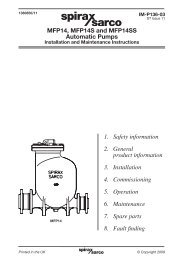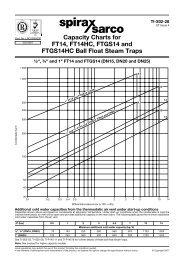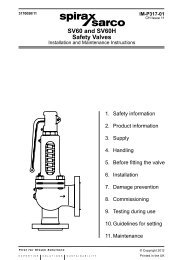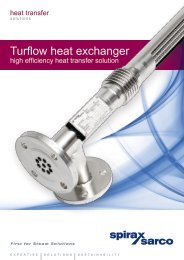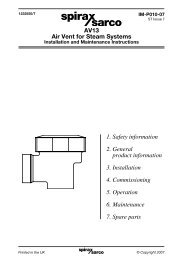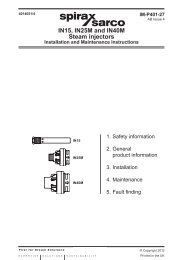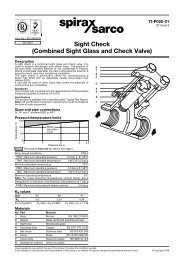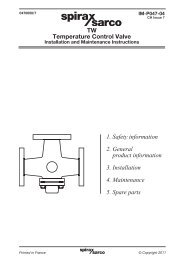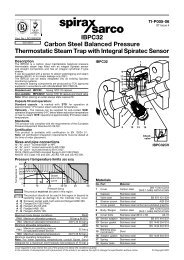SRV66HC High Capacity Sanitary Pressure ... - Spirax Sarco
SRV66HC High Capacity Sanitary Pressure ... - Spirax Sarco
SRV66HC High Capacity Sanitary Pressure ... - Spirax Sarco
You also want an ePaper? Increase the reach of your titles
YUMPU automatically turns print PDFs into web optimized ePapers that Google loves.
1866351/1<br />
<strong>SRV66HC</strong> <strong>High</strong> <strong>Capacity</strong><br />
<strong>Sanitary</strong> <strong>Pressure</strong> Reducing Valve<br />
Installation and Maintenance Instructions<br />
1. Safety information<br />
2. General<br />
product information<br />
3. Installation<br />
4. Operation<br />
5. Commissioning<br />
6. Maintenance<br />
7. Spare parts<br />
IM-P186-11<br />
CH Issue 1<br />
© Copyright 2012<br />
IM-P186-11 CH Issue 1 1<br />
Printed in the UK
2<br />
1. Safety information<br />
Safe operation of the unit can only be guaranteed if it is properly installed,<br />
commissioned and maintained by a qualified person (see Section 1.11) in<br />
compliance with the operating instructions. General installation and safety<br />
instructions for pipeline and plant construction, as well as the proper use of tools<br />
and safety equipment must also be complied with.<br />
1.1 Intended use<br />
Referring to these Installation and Maintenance Instructions, Name-plate and Technical<br />
Information Sheet, check that the product is suitable for the intended use / application.<br />
The product complies with the requirements of the European <strong>Pressure</strong> Equipment<br />
Directive 97/23 / EC and falls within Category 'SEP'. It should be noted that products<br />
within this category are required by the Directive not to carry the mark.<br />
i) The product has been specifically designed for use on steam, water and inert<br />
industrial gases. These fluids are in Group 2 of the above mentioned<br />
<strong>Pressure</strong> Equipment Directive. The product’s use on other fluids may be<br />
possible but, if this is contemplated, <strong>Spirax</strong> <strong>Sarco</strong> should be contacted to confirm<br />
the suitability of the product for the application being considered.<br />
ii) Check material suitability, pressure and temperature and their maximum and<br />
minimum values. If the maximum operating limits of the product are lower than<br />
those of the system in which it is being fitted, or if malfunction of the product<br />
could result in a dangerous overpressure or overtemperature occurance, ensure<br />
a safety device is included in the system to prevent such over-limit situations.<br />
iii) Determine the correct installation situation and direction of fluid flow.<br />
iv) <strong>Spirax</strong> <strong>Sarco</strong> products are not intended to withstand external stresses that may<br />
be induced by any system to which they are fitted. It is the responsibility of the<br />
installer to consider these stresses and take adequate precautions to minimise them.<br />
v) Remove protective covers from all connections and protective film from all nameplates,<br />
where appropriate, before installation on steam or other high temperature<br />
applications.<br />
1.2 Access<br />
Ensure safe access and if necessary a safe working platform before attempting to<br />
work on the product. Arrange suitable lifting gear if required.<br />
1.3 Lighting<br />
Ensure adequate lighting, particularly where detailed or intricate work is required.<br />
1.4 Hazardous liquids or gases in the pipeline<br />
Consider what is in the pipeline or what may have been in the pipeline at some<br />
previous time. Consider; flammable materials, substances hazardous to health,<br />
extremes of temperature.<br />
1.5 Hazardous environment around the product<br />
Consider; explosion risk areas, lack of oxygen (e.g. tanks, pits), dangerous gases,<br />
extremes of temperature, hot surfaces, fire hazard (e.g. during welding), excessive<br />
noise, moving machinery.<br />
IM-P186-11 CH Issue 1
1.6 The system<br />
Consider the effect on the complete system of the work proposed. Will any proposed<br />
action (e.g. closing isolation valves, electrical isolation) put any other part of the<br />
system or any personnel at risk?<br />
Dangers might include isolation of vents or protective devices or the rendering<br />
ineffective of controls or alarms. Ensure isolation valves are turned on and off in a<br />
gradual way to avoid system shocks.<br />
1.7 <strong>Pressure</strong> systems<br />
Ensure that any pressure is isolated and safely vented to atmospheric pressure.<br />
Consider double isolation (double block and bleed) and the locking or labelling of<br />
closed valves. Do not assume that the system has depressurised even when the<br />
pressure gauge indicates zero.<br />
1.8 Temperature<br />
Allow time for temperature to normalise after isolation to avoid the danger of burns<br />
and consider whether protective clothing (including safety glasses) is required.<br />
PTFE protective film<br />
If the PTFE protective film used inside the unit has been subjected to a temperature<br />
approaching 260°C or higher, it will give off toxic fumes, which if inhaled is likely to<br />
cause temporary discomfort. It is essential for a no smoking rule to be enforced in all<br />
areas where PTFE is stored, handled or processed as persons inhaling the fumes from<br />
burning tabacco contaminated with PTFE particles can develop 'polymer fume fever'.<br />
1.9 Tools and consumables<br />
Before starting work ensure that you have suitable tools and / or consumables<br />
available. Use only genuine <strong>Spirax</strong> <strong>Sarco</strong> replacement parts.<br />
1.10 Protective clothing<br />
Consider whether any protective clothing is required by yourself and / or others<br />
in the vicinity to protect against the hazards of, for example, chemicals, high / low<br />
temperature, noise, falling objects, and dangers to eyes and face.<br />
1.11 Permits to work<br />
All work must be carried out or be supervised by a suitably competent person.<br />
Installation and operating personnel should be trained in the correct use of the<br />
product according to these instructions.<br />
Where a formal 'permit to work' system is in force it must be complied with. Where<br />
there is no such system, it is recommended that a responsible person should know<br />
what work is going on and, where necessary, arrange to have an assistant whose<br />
primary responsibility is safety.<br />
Post 'warning notices' if necessary.<br />
1.12 Handling<br />
Manual handling of <strong>Spirax</strong>-<strong>Sarco</strong> products may present a risk of injury. Lifting,<br />
pushing, pulling, carrying or supporting a load by bodily force can cause injury<br />
particularly to the back. You are advised to assess the risks taking into account the<br />
task, the individual, the load and the working environment and use the appropriate<br />
handling method depending on the circumstances of the work being done.<br />
IM-P186-11 CH Issue 1 3
1.13 Residual hazards<br />
In normal use the external surface of the product may be very hot. If used at the<br />
maximum permitted operating conditions the surface temperature of some products<br />
may reach temperatures of 180°C.<br />
Many products are not self-draining. Take due care when dismantling or removing<br />
the product from an installation (refer to 'Maintenance instructions').<br />
1.14 Freezing<br />
Provision must be made to protect products which are not self-draining against<br />
frost damage if they are inoperative in environments where they may be exposed<br />
to temperatures below freezing point.<br />
1.15 Safety information - Product specific<br />
This product should not be dismantled without first releasing the compression on<br />
the control spring.<br />
1.16 Disposal<br />
This product is recyclable and no ecological hazard is anticipated with its disposal<br />
providing due care is taken, EXCEPT:<br />
PTFE protective film:<br />
- Can only be disposed of by approved methods, not incineration.<br />
- Keep PTFE waste in a separate container, do not mix it with other rubbish, and<br />
consign it to a landfill site.<br />
1.17 Returning products<br />
Customers and stockists are reminded that under UK and EC Health, Safety and<br />
Environment Law, when returning products to <strong>Spirax</strong> <strong>Sarco</strong> they must provide<br />
information on any hazards and the precautions to be taken due to contamination<br />
residues or mechanical damage which may present a health, safety or environmental<br />
risk. This information must be provided in writing including Health and safety data<br />
sheets relating to any substances identified as hazardous.<br />
4<br />
IM-P186-11 CH Issue 1
2. General product information<br />
2.1 Description<br />
The <strong>SRV66HC</strong> all stainless steel sanitary pressure reducing valve is a double seated, high<br />
capacity, spring loaded proportional control valve which also benefits from having a quick<br />
release body clamp ring. It is designed for hygienic applications in the food processing,<br />
brewing / beverage and pharmaceutical industries. The angle design allows for complete<br />
draining with no dead pockets and is suitable for use in CIP and SIP systems. The valve does<br />
not require an external pilot line.<br />
Valve tightness<br />
Valve tightness is in accordance with VDI / VDE guideline 2174 (leakage rate < 0.5% of<br />
Kvs value).<br />
Standard surface finish<br />
Internal wetted parts - standard surface finish of Ra < 3.2 µm. Please note: other surface<br />
finishes are available on request - contact <strong>Spirax</strong> <strong>Sarco</strong>.<br />
Note: For additional product data see Technical Information sheet TI-P186-10.<br />
2.2 Sizes and pipe connections<br />
DN25, DN40, DN50, DN65, DN80 and DN100 ISO 2852 sanitary clamp compatible.<br />
Please note: For other end connections contact <strong>Spirax</strong> <strong>Sarco</strong>.<br />
Fig. 1 <strong>SRV66HC</strong><br />
IM-P186-11 CH Issue 1 5
2.3 <strong>Pressure</strong> / temperature limits<br />
6<br />
Temperature °C<br />
300<br />
180<br />
130<br />
100<br />
0<br />
-10<br />
A B<br />
D<br />
Steam<br />
saturation<br />
curve<br />
0 2 4 6 8 10 12 14 16<br />
<strong>Pressure</strong> bar g<br />
The product must not be used in this region.<br />
The product should not be used in this region or beyond its operating range as<br />
damage to the internals may occur.<br />
A - B - C Maximum operating conditions for steam.<br />
D - E - C Maximum operating conditions for liquids and gases.<br />
Body design conditions<br />
Inlet PN16<br />
Outlet see '<strong>Pressure</strong> setting range' below<br />
Maximum design pressure 15.2 bar @ 50°C<br />
Maximum design temperature 300°C @ 9 bar g<br />
Minimum design temperature -10°C<br />
Maximum operating temperature<br />
EPDM diaphragm 130°C<br />
FPM diaphragm 180°C<br />
Maximum operating pressure (inlet) 8 bar g<br />
Minimum operating temperature -10°C<br />
Designed for a maximum cold hydraulic test pressure of: 24 bar g<br />
2.4 <strong>Pressure</strong> setting range<br />
Size DN40 - DN100 DN25 - DN100 DN25 - DN100<br />
Inlet / outlet PN16 / PN2.5 PN16 / PN6 PN16 / PN10<br />
Spring range 0.3 - 1.1 bar g 0.8 - 2.5 bar g 2.0 - 5.0 bar g<br />
E<br />
C<br />
IM-P186-11 CH Issue 1
3.1 General information<br />
Before installing the valve thoroughly flush the pipeline. Ideally the valve should be installed in<br />
a pressure reducing valve station, see Figure 2, at the very minimum there should be a strainer<br />
with a separator (not shown) fitted upstream, these should be serviced at regular intervals.<br />
The <strong>SRV66HC</strong> should always be fitted with the inlet horizontal and the spring housing directly<br />
above the valve. Most applications will require a safety valve to be installed downstream in<br />
case of accidental overpressure. It should be noted that the valve should not be used as a<br />
shut-off valve, a separate valve should therefore be used for isolation purposes if required.<br />
If it is possible for equipment downstream of the valve to be shut off then a further trap set<br />
should be installed to prevent downstream flooding.<br />
The pressure reducing valve should not be insulated as this may lead to over heating and<br />
destroy the elastomer seals.<br />
Steam<br />
flow<br />
Fig. 2 Recommended installation<br />
2<br />
2<br />
6<br />
1<br />
3. Installation<br />
Bypass for maintenance<br />
3<br />
1 Strainer 4 Safety valve<br />
2 Stop valves 5 <strong>Pressure</strong> gauge<br />
3 <strong>Pressure</strong> reducing valve 6 Leakage line G (option)<br />
IM-P186-11 CH Issue 1 7<br />
4<br />
2<br />
5<br />
4
4.1 How the <strong>SRV66HC</strong> works<br />
The outlet pressure to be controlled is balanced across the diaphragm by the force of the valve<br />
spring (set pressure). As the outlet pressure rises above the pressure set using the adjustment<br />
screw, the valve cone moves towards the seat and the volume of medium is reduced. As the<br />
outlet pressure drops the valve control orifice increases; when the pipeline is depressurised<br />
the valve is open. Rotating the adjusting screw clockwise increases the outlet pressure.<br />
8<br />
Steam<br />
flow<br />
Adjustment screw<br />
Valve spring<br />
Diaphragm<br />
Fig. 3 How the <strong>SRV66HC</strong> works<br />
4. Operation<br />
Controlled outlet<br />
pressure<br />
Rotating the adjusting screw<br />
clockwise increases the<br />
outlet pressure.<br />
IM-P186-11 CH Issue 1
5.1 Start-up and adjustment:<br />
- First make sure that all stop valves are closed.<br />
- Check that the control spring is not compressed, wind the adjuster screw anticlockwise<br />
if necessary.<br />
- Open the stop valves in the following order:<br />
i - Open the stop valve (A) immediately in front of the steam trap.<br />
ii - Open the downstream stop valve (B).<br />
iii - Very gently open the upstream valve (not shown) on the inlet supply line to avoid any<br />
sudden mechanical or thermal shock.<br />
Steam<br />
flow<br />
Fig. 4 <strong>SRV66HC</strong> - Commissioning<br />
A<br />
5. Commissioning<br />
Bypass for maintenance<br />
E<br />
- Slowly turn the adjuster screw clockwise until the desired downstream pressure is<br />
achieved (C). If the valve is set under no-load conditions then there will be a proportional<br />
offset causing the controlled pressure to drop by about 20% under flowing conditions.<br />
If the valve is set under normal flowing conditions then there will be a pressure rise of<br />
about 20% due to the proportional offset of the valve as the load reduces to zero. It is<br />
important that any downstream safety valve (D) is set such that the no-load set pressure of<br />
the <strong>SRV66HC</strong> (E) is below the safety valve reseat pressure.<br />
IM-P186-11 CH Issue 1 9<br />
D<br />
B<br />
C
10<br />
6. Maintenance<br />
6.1 General inspection<br />
While a programme of planned maintenance is always recommended, the <strong>Spirax</strong> <strong>Sarco</strong><br />
<strong>SRV66HC</strong> will give long and trouble free service if correctly selected, installed and kept free<br />
of dirt and foreign matter. Dirt and foreign matter are most likely to collect during installation<br />
and later trouble can be avoided by inspecting the installation after a few days.<br />
Check the following:<br />
- Clean all pipeline filters or strainers (remove elements or screens to clean).<br />
- Check all joints for leakage.<br />
6.2 Inspecting / replacing diaphragm and valve assembly:<br />
- Before attempting any maintenance operation read the product specific safety information<br />
in Section 1.15.<br />
- Isolate the valve, first closing the upstream isolating valve (A) and then the downstream<br />
isolating valve (B). Check that the pressure is zero (C) and allow the valve to cool (see Figure 5).<br />
Steam<br />
flow<br />
A<br />
Fig. 5 Isolate the valve<br />
Bypass for maintenance<br />
- Release the compression on the control spring (6) by turning the adjustment screw<br />
(19) anticlockwise.<br />
- Remove the <strong>SRV66HC</strong> from the pipeline.<br />
- Lift off the spring housing (7) and the control spring (6) by first releasing the 'V' band clamp<br />
screws and then removing the 'V' band (18).<br />
- Grip the flats visible on the main valve end and undo the lock-nut (16) clamping the<br />
diaphragm (12) and diaphragm plates (3 and 4). Please note: that when refitting the<br />
diaphragm plates the side with the radius should abut the diaphragm face.<br />
- The diaphragm and diaphragm plates (12, 3 and 4) can then be removed from the main<br />
valve which should be carefully lowered and removed via the valve inlet. Note the d i a p h r a g m<br />
'O' ring seal (17) which sits against the diaphragm PTFE face on the wetted side.<br />
- Reassemble in reverse order ensuring the PTFE (light colour) side of the two-part<br />
diaphragm is on the wetted side.<br />
B<br />
C<br />
IM-P186-11 CH Issue 1
18<br />
12<br />
4<br />
Fig. 6 Maintenance<br />
IM-P186-11 CH Issue 1 11<br />
19<br />
7<br />
6<br />
16<br />
3<br />
17
The spare parts available are detailed below. No other parts are supplied as spares.<br />
Available spares<br />
Diaphragm, 'O' ring and gasket kit 10, 11, 12, 13, 17, 20<br />
How to order spares<br />
Always order spares by using the description given in the column headed 'Available spares'<br />
and state the size, model, pressure range and PN rating.<br />
Example:<br />
1 - Diaphragm, 'O' ring and gasket kit for a <strong>Spirax</strong> <strong>Sarco</strong> DN40 <strong>SRV66HC</strong> direct acting<br />
pressure reducing valve having a pressure range of 0.8 to 2.5 bar g and a PN16 / PN6 rating<br />
and FPM diaphragm.<br />
12<br />
13<br />
Fig. 7 <strong>SRV66HC</strong> spares<br />
12<br />
7. Spare parts<br />
20<br />
17<br />
11<br />
10<br />
IM-P186-11 CH Issue 1



